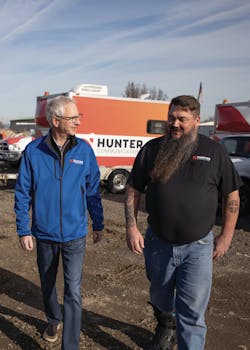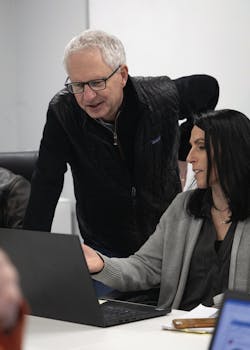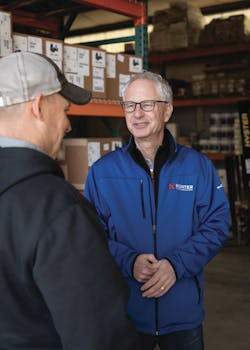Executive Insights with Michael Wynschenk, CEO, Hunter Communications
Topic: What is your “Why?”
Michael Wynschenk: Our mission is to help our customers create lasting and meaningful connections with each other, their communities, their customers, and the world.
This is not an easy industry. What we do is hard. We are building networks in extreme weather conditions. We enter homes as strangers and leave as friends. Because what our industry does matters. What Hunter does matters.
Topic: Community Connections
ISE: To celebrate your May 2023 expansion into Chiloquin, Oregon, you hosted a Community Pizza Party at the Chiloquin Community Center. You also run campaigns to reduce cyberbullying and offer scholarships to students across your service area. Share two other ways you strengthen community connections in telehealth, developing a homegrown workforce and digital inclusion.
Wynschenk: The pandemic saw a boom in the use of telemedicine like nothing we’ve ever seen before. According to the Journal of American Medical Association, there were less than 1 million telemedicine visits nationwide in 2019. That number skyrocketed to over 50 million during the pandemic. The Pacific Northwest utilizes telemedicine almost twice as much as other regions in the country.
At Hunter, we provide symmetrical fiber internet service to our residential customers, vital for a strong video connection during a telemedicine appointment. We also provide fiber optic service to most of the region's larger hospitals and medical facilities, including Asante and Three Rivers Medical Center. Upload speeds at the home and the medical facility are imperative for doctors to communicate clearly and accurately diagnose medical conditions.
While Hunter participates in ACP, we have also created special pricing programs for Veterans and active military personnel, teachers, and parents. In December, we launched the Hunter Family Safety Bundle, which includes our symmetrical fiber optic internet and our Hunter Shield Suite of Internet security products, enabling parents to monitor cyberbullying while building trust and helping their children maintain privacy. This aligns with our values of providing fast, reliable, affordable, and safe internet.
Topic: Community Employment
ISE: Given labor challenges, how does Hunter attract, train, and retain workers from the areas it serves?
Wynschenk: Customers and employees are attracted to our company because of our service reputation. On a scale of 1-5, our Google rating is 4.8—the highest of any internet service provider in the Pacific Northwest. Our reputation provides a distinct advantage in employee recruitment. People want to work for a company they can be proud of and where they can make a difference.
Topic: Muni Partnerships
ISE: Why should municipalities work with a network provider instead of building their fiber networks?
Wynschenk: A municipality’s core competency is not owning or operating a fiber network in a competitive environment where cable and telecom companies already provide service. Having a five-to-10-year plan to upgrade and reinvest in technology is a requirement to remain relevant in our industry; this is a foreign concept to most municipalities.
The general nature of municipalities could be more conducive to change. Turnover of elected officials and management employees in the public sector can lead to shifts in focus and priorities based on what is important to each official at that moment. This can hinder a municipality’s ability to overcome the inevitable collective challenges.
Topic: Crystal Ball for the ICT/Telecom Landscape
ISE: What’s next for our industry?
Wynschenk: The future is faster, more reliable internet with continued progress on digital equity, and that is focused on internet safety.
Companies like Hunter will work with partners and in-house developers to introduce new applications to leverage the millions of miles of fiber that have yet to be placed. This includes making the internet safer, improving business productivity, and enhancing in-home entertainment experiences.
Topic: Workforce Retention
ISE: What is the telecom industry missing in recruiting/retaining younger professionals? What is the company doing in this area?
Wynschenk: Young professionals want to be engaged, they want to be developed, and they want to have exposure to leaders in the business. They want to be mentored.
Members of our leadership team host immersion meetings to address business challenges. This is where management and employees work together to create better results for the business and our customers. Employees are at the decision-making table and find the experience and exposure invaluable.
In 2022, we launched our “Get Ready” Program, which helps facilitate career progression through employee training and mentorship. This program has matured from where department heads nominated employees to where employees participate in an application process. Our inaugural class saw seven out of 10 participants “graduate” and promoted to next-level roles. We are currently preparing to complete the training for the second graduating class.
Our Construction department utilizes a formal apprenticeship program, where individuals with little experience can grow from a ground hand into an aerial lineman. There are eight different tiers that a construction employee needs to complete, with the possibility of program completion in as little as two years. Since its inception, we have promoted 17 employees through this program.
Topic: The Future
ISE: What emerging or disruptive broadband technology excites you the most? Why?
Wynschenk: To say the pandemic was disruptive is an understatement. But it affected our industry differently than others. It opened society’s eyes to internet capabilities that were always underutilized. Telehealth, working-from-home, online classes, and streaming were all there before the pandemic.
As we look to the future, it will get even more disruptive. The fiber speeds available by 2034 will be virtually unlimited compared to how we think today. In 2018, the industry identified the “Super Power User” as a subscriber using 2TB of monthly data. In 2023, a new category was established—the “Extreme Power User.” Extreme Power Users make up more than half of all internet subscribers today and use 5TB or more of data each month.
In 10 years, TV sets may be obsolete, and the in-home entertainment experience will be radically different, supported by many of the technology builders in our country. Companies like Cisco, Meta, and Microsoft are building technology and entertainment solutions to blow consumers’ minds.
Approximately 170 million people worldwide use virtual reality, and its future is increasingly leaning toward multisensory experiences. It's not just about what users can see but what they can touch, smell, and even taste. The more realistic the virtual world, the more immersive and captivating the experience will be for the user.
From gaming and social media to medical treatment and education, virtual reality will transform and enhance our most significant and even the littlest experiences. This technology will rely heavily on the internet service companies like Hunter Communications provide.
Topic: The Elephant in the Room
ISE: What is our industry NOT addressing that it should in terms of network evolution and broadband for all?
Wynschenk: As an industry, we need to better educate consumers about the risks associated with the internet and help them make informed decisions about what personal information they share. We provide access to technology that can harm people. These solutions need to cover everyone in the family, including senior citizens.
At Hunter, we have recently launched Hunter Shield—our suite of internet security products to protect residential consumers and small businesses from viruses, spyware and malware, cyberattacks, and cyberbullying. These products are a start, but there is still much to be done at an industry level.
Topic: Fiber Field Realities
ISE: Time, talent, and cost are the enemies in deploying fiber deeper in the last mile. What are the best ways to help defeat those enemies?
Wynschenk: Our industry and society goals should be ubiquitous access, not a ubiquitous delivery system. Fiber is not necessarily always the answer; however, when it is the answer, communities should support and endorse micro-trenching. As BEAD dollars flow into the industry, states must move quickly to improve the permitting process, including funding positions to accommodate timely execution.
All parties must also be open to other solutions, including fixed wireless. As the FCC deploys additional spectrum, we must consider last-mile fixed wireless technology to ensure our most rural customers have access to high-speed service.
To overcome these enemies, firms need a strategy incorporating people, processes, and technology, which leads to overall financial health. Continually leveraging technologies in all departments will lead to improved processes and efficiencies.
ISE: Telecom providers still have trouble converting “homes passed” to “homes connected.” Only 20 countries across the globe currently have more than a 50% fiber penetration rate. What’s a feasible solution?
Wynschenk: In 2020, we were able to pivot following the pandemic and started to expand our fiber network to residential neighborhoods near our commercial customers. We removed all barriers to success with our offer strategy. We gave consumers fast and reliable service at an affordable price with lifetime pricing, no contracts, no router fees, and no data caps.
Once we started to generate brand awareness around our residential service, customers began coming to us. We focus on the importance of social media to tell our success stories while ensuring the in-home experience is easy for customers, resulting in a positive experience.
Many providers employ a “If you build it, they will come” mentality. At Hunter, we do the opposite and bring our fiber network where consumers have expressed interest. This way, we decrease our CPGA and increase our penetration rates quickly.
Topic: Hunter Communications 3,000-plus Fiber Network
ISE: How does Hunter Communications build its fiber networks? What portion of your deployment is handled in-house versus by contractors? Share two best field deployment practices your team can teach other network providers that improve time-to-market and reduce cost-per-mile and unit passed.
Wynschenk: Hunter Communications is a 30-year-old company that started as a construction firm specializing in fiber networks. In the early 2000s, we began building our network, focusing exclusively on commercial accounts, including schools, hospitals, and state agencies. This created significant expertise in engineering, permitting, and all phases of the construction process.
We then pivoted in the early stages of the pandemic to expand this capability to include residential neighborhoods.
Our best practices utilize lean processes to document and detail our project plans, leveraging highly collaborative interdepartmental engagement. This begins with pre-build customer registration via our website and concludes with our sales and marketing plan, which leads to a high penetration level within the first six months of service availability.
We have recently started supplementing our activity with subcontractors to keep up with the significant demand for our services. Eighty-five percent (85%) of our engineering is completed in-house, along with 70% of our construction and splicing.
Topic: Change Management and Culture
ISE: What have you learned about culture and change management that help your teams succeed?
Wynschenk: To influence company culture, businesses must clearly define and communicate their mission and brand values. At Hunter, we developed both with our employees’ feedback through surveys and in-person sessions to ensure our process was inclusive. Our values include fighting for our customers, doing the right thing, and putting all people first. They give us a barometer to measure against. We don't do it if it doesn’t align with our mission and brand values.
We have also created a culture that involves employees in decision-making processes to help them understand our why and to help us succeed. Too often, leaders focus on setbacks instead of celebrating achievements. Our employees have firsthand experience in what is and what isn’t successful. It is essential to involve them in identifying challenges and implementing solutions.
Topic: Leadership Style
ISE: Please share ONE word that encapsulates your leadership style. And ONE word that describes you as a person.
Wynschenk: I want to think the one word that describes my leadership style is “inspiring.” I selected that word because I am passionate about this industry, which I’ve been in for over 35 years. I have learned that people want to be a part of something bigger than themselves, and when given an opportunity, they will work together to accomplish great things.
Topic: Out-of-the-Box Thinking
ISE: How has the Hunter Communications Network team colored outside the lines to do business differently and better for its employees?
Wynschenk: We are disruptors in our industry. Nothing we do is cookie-cutter, from our offers and approach to the market to our recruitment and retention strategies.
We encourage and act upon employee feedback through quarterly surveys (which have an 85% response rate), live and in-person town hall meetings, and skip-level management sessions. We act quickly to address and solve employee concerns. Our underlying methodology is training and development, from our Senior Leadership Team to all employees.
We can also pivot to address products and services when we experience sales challenges. If a particular geographical area isn’t responding well to an offer we have released, we modify it as quickly as two weeks.
Topic: Inspiration
ISE: In growing organizations, there can be a tendency for the “institution” to dampen the “inspiration.” How do you keep this from happening on your team as you grow?
Wynschenk: Our inspiration built our institution. Employees know and understand our why. We reference it frequently in how we make decisions. Our strategic pillars—people, process, technology, and financial health—also keep us focused on doing what is right.
Several leadership team members from larger companies came to Hunter because they could affect real change and make an impact here. Our environment supports being disruptive and gives our employees the autonomy to make a difference.
Topic: Personality Trait
ISE: What’s an essential personality trait someone needs to succeed in a company like Hunter Communications?
Wynschenk: Leadership is a trait we look for all employees to have. We seek those who are confident in their decision-making capabilities yet nimble enough to learn from mistakes, resulting in the ability to change direction when needed.
Collaboration is essential here as we have grown fast, move fast, and compete hard as a team. To succeed at Hunter Communications, working cross-functionally with a strong sense of urgency is critical to creating success for our customers and investors.
Michael Wynschenk joined Hunter Communications in April 2020 as Chief Executive Officer. Wynschenk is a seasoned executive with senior leadership experience with wireline and wireless carriers. With more than 30 years of experience in the telecommunications and cable industry, he has a strong track record of growth acceleration and value creation. Wynschenk has held leadership roles at a variety of regional and national firms including AT&T, Verizon, Altice, Alaska Communications, and BendBroadband.
Hunter Communications is the fastest growing telecommunication provider in the northwest. Known for its outstanding customer service, highly engaged employees, and disruptive approaches in the market. Hunter began as a construction company 30 years ago. The firm pivoted to provide fiber services to businesses in the early 2000s, and entered the residential market during the pandemic, offering FTTH throughout the state of Oregon. In 2021, Hunter acquired McMinnville Access Company and in 2023, Hunter acquired Origin Networks, LLC, both under Wynschenk’s leadership, thus expanding the company’s serviceable footprint.
For more information, visit https://hunterfiber.com. Follow Michael on Linkedin. Follow Hunter Communications on LinkedIn, Facebook and Twitter.
About the Author
Sharon Vollman
Content Ambassador for ISE EXPO
Sharon Vollman is the Content Ambassador for ISE EXPO. She is passionate about collaborating with thought leaders, SMEs and hard-working doers who design, plan and deploy ultra-reliable broadband networks. Vollman is committed to creating a variety of educational offerings for ISE EXPO attendees that inspire them to connect every U.S. citizen with the broadband networks we all want for our children and grandchildren.
Vollman has created educational partnerships with Broadband Service Providers including AT&T, Verizon, Lumen, Frontier Communications and others. She has covered the telecom industry since 1996.





